Why grow cucumbers in a hoop house? There are two main reasons: First, cucumbers are heat loving plants, and a hoop house lets you plant sooner and grow longer than growing outside. Second, a hoop house acts as a barrier to pests by stopping insects and herbivores from eating or infecting your plants.
This article shows you how to take full advantage of a small, backyard hoop house to grow more and better cucumbers. Let’s start by looking at some of the problems with growing cucumbers outside.
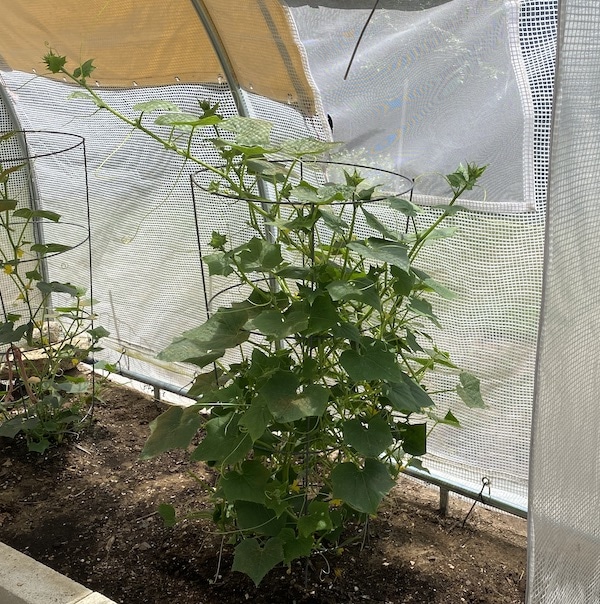
Table of Contents
Let’s take a sec to get the legal words out of the way. This article may contain affiliate links. That means if you click and buy from my partners, I will make a tiny amount of money at no cost to you. This in no way affects my recommendations.
Cucumber growing problems
A lot of people run into trouble growing cucumbers when they first transplant their seedlings outside. Often, the weather is less than cooperative.
Cold, sunless weather will stunt the growth of cucumber plants. It sometimes would be better if you left them in the pot for a month after the last frost date rather than put them in the cold ground where they don’t do so well.
Cold weather at the END of the growing season is also a problem. It prematurely ends the harvest because cucumbers don’t do well when the temperature drops below 60 degrees Fahrenheit.
Cucumber beetle
Even more destructive than bad weather are pests. This is my BIG problem with growing cucumbers outside.
My outdoor plants give well until about the middle of July. Then they wilt.
At first, this is only during the heat of the day. But increasingly the wilting grows worse until the leaves die and cucumber production drops off.
The culprit, I believe, is the cucumber beetle. It munches on the plant and infects it with a disease, causing a slow death.

Extend the Growing Season
All my articles on hoop houses, cold frames, indoor growing, winter sowing and more!
Herbivores
But the cucumber beetle isn’t the only cucumber predator in my backyard. My neighborhood is infested with groundhogs. They love cucumber leaves and will mow down a plant in 15 minutes.
If a groundhog wants your cucumber plant, they will dig their way in. I’ve had this happen several times. But at least you can add garlic and hot pepper to the leaves. This may convince them that it’s too much risk and trouble to eat the plants in the hoop house.
Deer also make their way through my yard (on the way to my apple trees, which they love). Cucumber plants are not their favorite. But deer still will stop for an early morning snack if the opportunity presents itself.
A hoop house protects cucumber leaves from deer.
Earlier cucumbers
When you grow cucumbers in a hoop house, you will get fruit a little sooner. This is especially true if you plant cucumbers that don’t need pollination (see below).
But there’s an easy trick to getting early cucumbers even earlier. It is, however, a little counter intuitive.
If you wait to transplant your seedlings into the hoop house ground and leave them in the pot, they become a little pot bound. The result is they focus their energy on growing cucumbers instead of growing out the plant.
Related: How to Reuse Windows in the Garden
I get an early cucumber from every plant that I let get pot bound.
Transplanting pot bound plants means the plants will take longer to grow out, so I leave some in the pots and others I plant as soon as possible.
Trellising in a hoop house
Market farmers who grow hoop house cucumbers use a method of training the vines called the umbrella method. This is where the vines are trained to run up to a wire suspended about six feet above the ground.
As a result, the vines form a canopy with cucumbers hanging down. It’s sort of like an umbrella, hence the name.
Backyard growers have been using grape arbors forever. This is like an arbor for cucumbers.
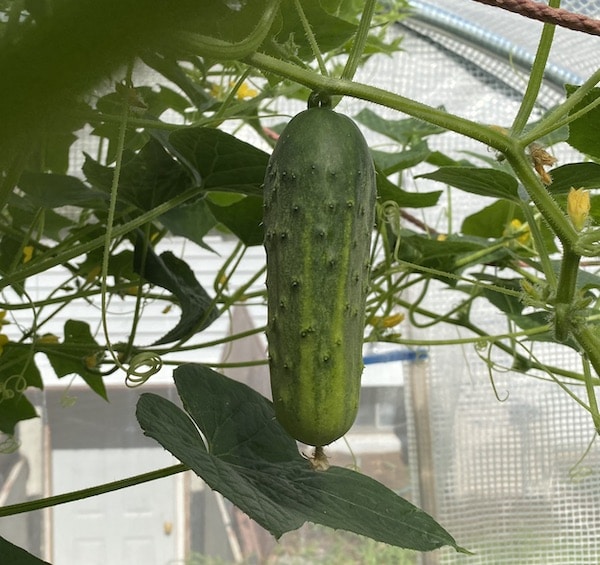
The umbrella method, or some variation on it, is a very productive and cool method of growing cucumbers. But I don’t find it suited for growing cucumbers in small, backyard hoop houses.
If I grew cucumbers across the roof of the hoop house, it would shade the other plants. There just isn’t enough space in my high tunnel for this method.
Instead I use a traditional tomato cage and let the cucumber plant grow out. This works well when you are planting under the sidewall.
The cucumber plants grow up the cage and back down, giving them room to expand. Plus, the fruit are kept off the grown, which prevents yellowing of the cucumber underside.
Which type of cucumbers are best?
Indeterminate cucumber varieties are the most popular in my area. These grow fruit on vines that continue to grow throughout the growing season.
There are, however, determinate (a.k.a., bush) varieties. These have the advantage of only taking up a limited amount of valuable hoop house space.
Bush cucumbers fit nicely under the sidewall of a backyard hoop house. Still, I don’t think their best for the backyard grower.
The whole point of growing cucumbers in a hoop house is to extend the growing season. If your plants are NOT going to continue growing, and you’re only going to get a finite amount of fruit, why grow in a hoop house?
Like most market farmers, I grow a variety that needs no pollination. This is because I want to keep bad bugs out.
Wet leaves are a main cause of powdery mildew.
— Suburban Hobby Farmer
Keeping bad bugs out means no pollinators, too. So cucumbers that you must pollinate won’t give fruit unless you hand pollinate them.
Unlike tomatoes, which have male and female on one flower. Cucumbers have two different flowers. Hand pollination is a little difficult. I prefer to grow Little Leaf cucumber plants that need no pollination. I get them from Reimer Seeds.
Watering Hoop House Cucumbers
Cucumbers grown in a hoop house need watering because it doesn’t rain indoors. Well, this is an obvious statement!
No rain is both good and bad.
It’s good because you can prevent leaves from getting wet. Wet leaves are a main cause of powdery mildew.
I’ll say that a different way because it’s important: If you don’t water cucumber plants from the top, you can prevent powdery mildew. This is common cucumber disease.
But, of course, if there’s no rain inside, that means you must water frequently. If you don’t, they will do badly because cucumbers need consistent watering.
When cucumbers are first transplanted, you need to water them everyday. You probably would outdoors, too.
Once they are established, you should deep water twice a week. If the hoop house is very warm, say over 90 degrees Fahrenheit , water every other day.
Remember, the cucumber plant roots will likely grow outside of the hoop house. This means that when it rains outdoors, they will likely get water then, too.
The bottom line on watering is that cucumbers need heavy, consistent watering. This is especially true in a hot house. So don’t skimp on the watering.
Feeding your plants
Whenever you ask a question about plant feeding, the answer will always be “use more high quality, finished compost.” Feeding cucumbers is no different.
Besides more compost, you should also apply Neptune’s Harvest liquid fertilizer about every 14 days or so during the harvest. Cucumbers are heavy feeders.
Related: Neptune’s Harvest Product Review.
Obviously, you should keep the beds free of weeds. If you don’t, cucumber plants will have to compete for water and nutrients. Unfortunately, cucumber plants don’t compete very well.
Hoop house temperature control
Cucumber plants grow best in temperatures between 60 and 90 degrees Fahrenheit. The cucumber varieties I grow do best at the high end of that range.
Obviously, some varieties grow well in cooler temperatures and others prefer it hot.
You should realize that even small hoop houses can easily reach and stay at 110 degrees all afternoon long. This is true even of when all the doors and windows are open.
To keep an eye on the hoop house temperature, I use a wifi thermometer that allows me to check from inside the house.
I place the thermometer sensor in a shady spot in the hoop house so that I get an accurate temperature reading. Otherwise, it would show a temperature much higher than the actual air temperature.
When it’s hot, I open all the windows and the door. These are screened to keep the bad bugs out.
There is natural air flow as the hot air inside the hoop house heats up and escapes through the windows. Cool air is sucked in as the hot air leaves.
Market growers also use fans and shade cloths to bring the temperatures down. I do use a shade cloth in the summer, but I don’t use a fan.
In the summer, I find that cucumbers get plenty of sun in the morning and can use some cooling in the afternoon. The shade cloth helps the cucumbers grow faster because it keeps the temperature down.
How to grow cucumbers in a hoop house
Here is my method for growing cucumbers:
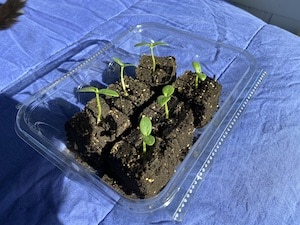
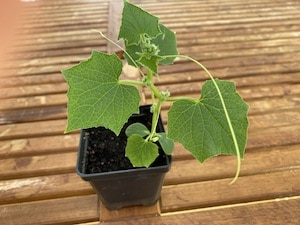
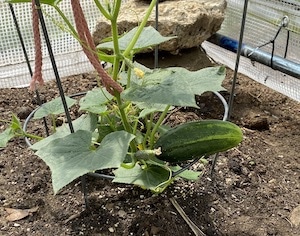
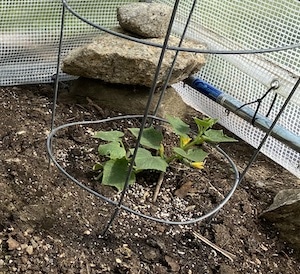
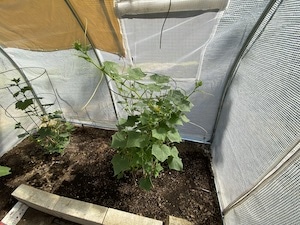
Now that you’ve read this article, you are an expert on growing cucumbers in a hoop house.
Related articles you might enjoy:
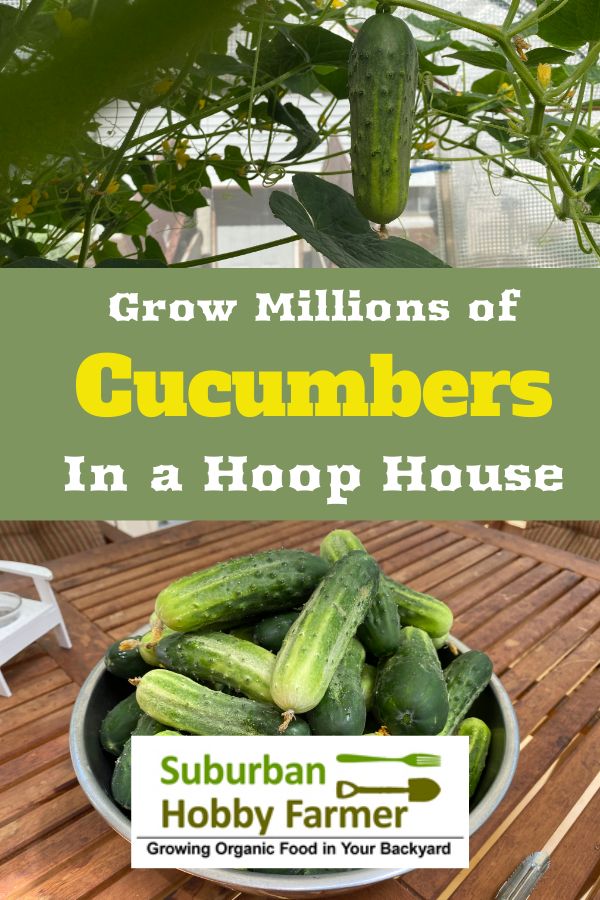
Suburban Hobby Farmer is a participant in the Amazon Services LLC Associates Program, an affiliate advertising program designed to provide a means for sites to earn advertising fees by advertising and linking to amazon.com.